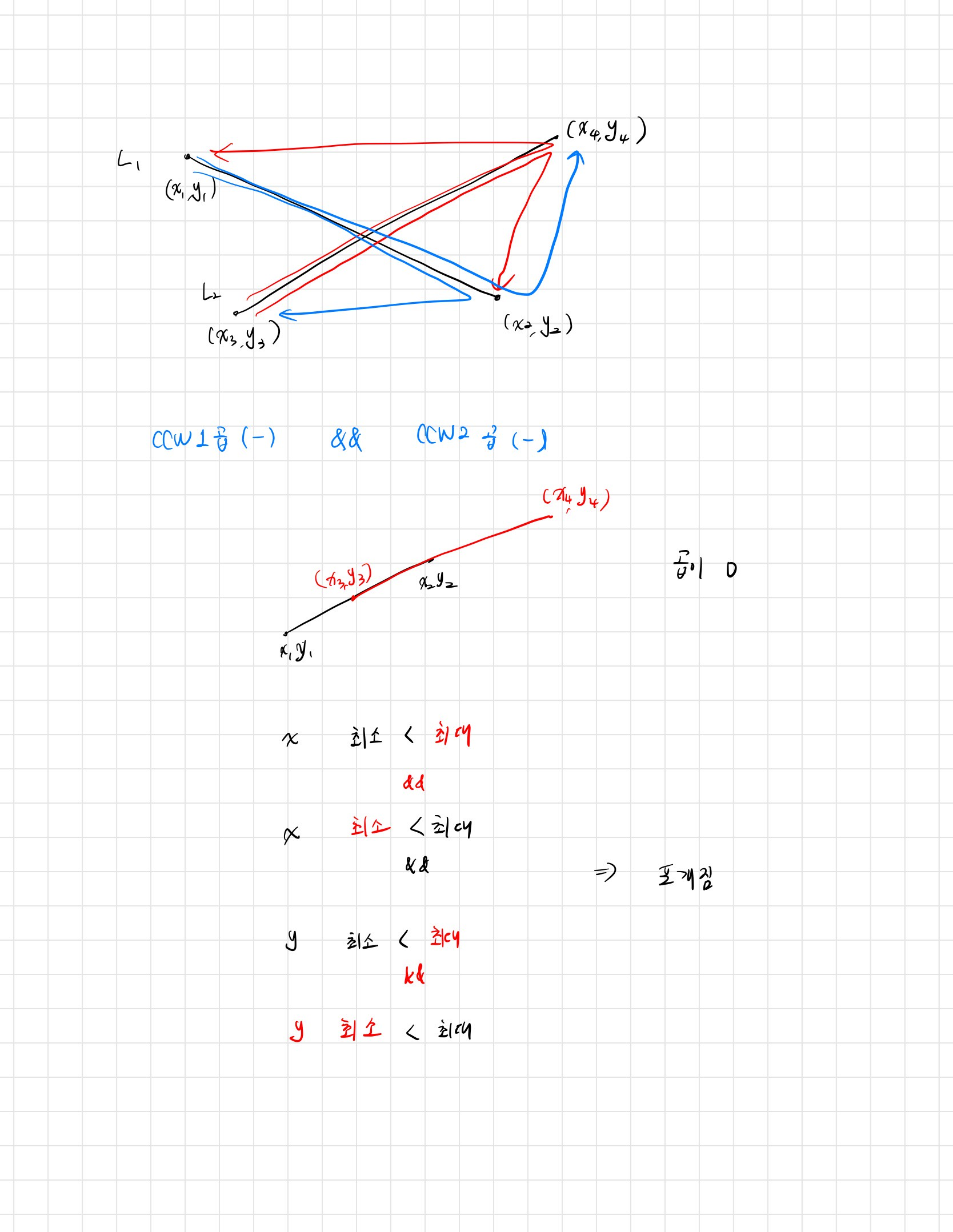BOJ_17387_선분 교차 2 (Java)
BOJ_17387_선분 교차 2 (Java)
[Gold II] 선분 교차 2 - 17387
성능 요약
메모리: 14264 KB, 시간: 100 ms
분류
많은 조건 분기, 기하학, 선분 교차 판정
제출 일자
2024년 10월 14일 04:18:15
문제 설명
2차원 좌표 평면 위의 두 선분 L1, L2가 주어졌을 때, 두 선분이 교차하는지 아닌지 구해보자. 한 선분의 끝 점이 다른 선분이나 끝 점 위에 있는 것도 교차하는 것이다.
L1의 양 끝 점은 (x1, y1), (x2, y2), L2의 양 끝 점은 (x3, y3), (x4, y4)이다.
입력
첫째 줄에 L1의 양 끝 점 x1, y1, x2, y2가, 둘째 줄에 L2의 양 끝 점 x3, y3, x4, y4가 주어진다.
출력
L1과 L2가 교차하면 1, 아니면 0을 출력한다.
문제 풀이
코드
1
2
3
4
5
6
7
8
9
10
11
12
13
14
15
16
17
18
19
20
21
22
23
24
25
26
27
28
29
30
31
32
33
34
35
36
37
38
39
40
41
42
43
44
45
46
47
48
49
50
51
52
53
54
55
56
57
58
59
60
61
62
63
64
65
/**
* Author: nowalex322, Kim HyeonJae
*/
import java.io.*;
import java.util.*;
public class Main {
static BufferedReader br;
static BufferedWriter bw;
static StringTokenizer st;
public static void main(String[] args) throws Exception {
new Main().solution();
}
public void solution() throws Exception {
br = new BufferedReader(new InputStreamReader(System.in));
// br = new BufferedReader(new InputStreamReader(new FileInputStream("input.txt")));
bw = new BufferedWriter(new OutputStreamWriter(System.out));
st = new StringTokenizer(br.readLine());
long x1 = 0, y1 = 0, x2 = 0, y2 = 0, x3 = 0, y3 = 0, x4 = 0, y4 = 0;
x1 = Long.parseLong(st.nextToken());
y1 = Long.parseLong(st.nextToken());
x2 = Long.parseLong(st.nextToken());
y2 = Long.parseLong(st.nextToken());
st = new StringTokenizer(br.readLine());
x3 = Long.parseLong(st.nextToken());
y3 = Long.parseLong(st.nextToken());
x4 = Long.parseLong(st.nextToken());
y4 = Long.parseLong(st.nextToken());
int res = isCrossed(x1, y1, x2, y2, x3, y3, x4, y4) ? 1 : 0;
System.out.println(res);
bw.flush();
bw.close();
br.close();
}
private static int ccw(long x1, long y1, long x2, long y2, long x3, long y3) {
long res = (x1 * y2 + x2 * y3 + x3 * y1) - (x1 * y3 + x2 * y1 + x3 * y2);
if (res == 0) return 0;
else if (res > 0) return 1;
else return -1;
}
private static boolean isCrossed(long x1, long y1, long x2, long y2, long x3, long y3, long x4, long y4) {
int ccw1 = ccw(x1, y1, x2, y2, x3, y3);
int ccw2 = ccw(x1, y1, x2, y2, x4, y4);
int ccw3 = ccw(x3, y3, x4, y4, x1, y1);
int ccw4 = ccw(x3, y3, x4, y4, x2, y2);
if (ccw1 * ccw2 == 0 && ccw3 * ccw4 == 0) {
return isOverlap(x1, y1, x2, y2, x3, y3, x4, y4);
}
return (ccw1 * ccw2 <= 0 && ccw3 * ccw4 <= 0);
}
private static boolean isOverlap(long x1, long y1, long x2, long y2, long x3, long y3, long x4, long y4) {
return Math.min(x1, x2) <= Math.max(x3, x4) && Math.min(x3, x4) <= Math.max(x1, x2) &&
Math.min(y1, y2) <= Math.max(y3, y4) && Math.min(y3, y4) <= Math.max(y1, y2);
}
}
This post is licensed under
CC BY 4.0
by the author.

